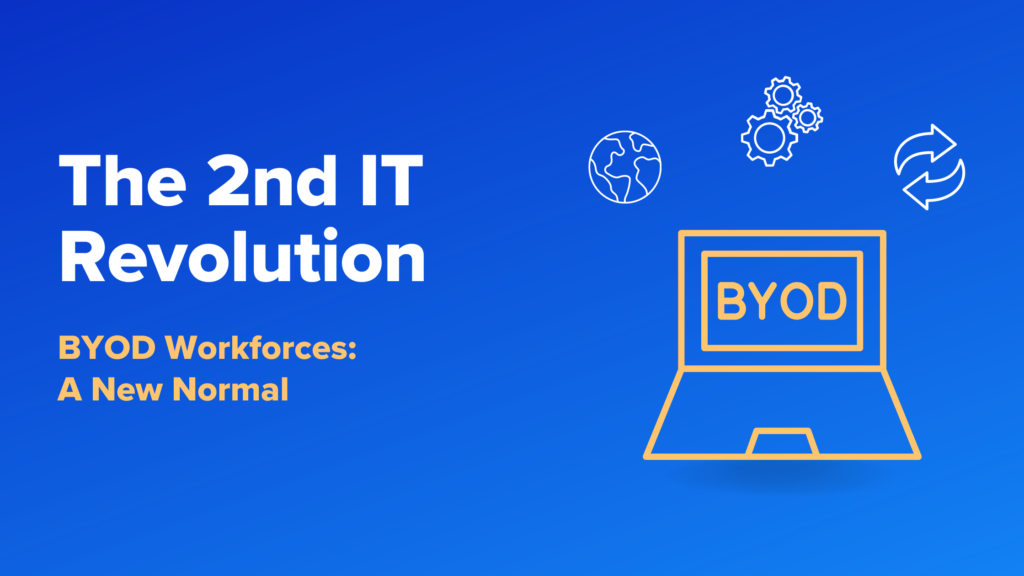8 Questions to Help you Build Your Secure BYO-PC Program

The growing trend of BYOD (Bring Your Own Device) and BYO-PC (Bring Your Own PC) laptops requires attention from organizations and CIOs. By building a Secure BYO-PC program, IT leaders can ensure they drive employee productivity, enhance organizational cost savings and increase employee satisfaction. In this blog post, we detail the 8 questions you should ask yourself when building a Secure BYO-PC program. We also explain how to find the right solution for your needs.
For more details, stats and bonus information, you can read the complete eBook that this blog post is based on, here.
Why Secure BYO-PC Now?
has become increasingly popular across organizations. 67-77% of employees already use their personal devices at work, even if their workplace has not installed a formal BYO-PC, or BYOD, program. At a macro-economic level, the BYOD market is projected to grow by $69.07 billion. This means that BYOD is already here, is here to stay, and that adoption will continue to accelerate.
The expected growing use of BYOD is the result of three main trends. First, professional and personal lines are becoming blurred and organizations need to find a way to support remote work. Second, organizations are adding more independent contractors, and temporary and offshore workers to their supply chains. Third, provisioning and supporting laptops for employees is becoming expensive, especially when IT needs to ship devices to remote workers. BYOD provides a cost-effective solution to these needs.
However, with BYOD comes great risk. When employees use their own devices, organizations lose control over sensitive data and applications. They cannot govern who has access, how and where it’s stored and which protective measures are used to secure it. BYOD also makes it harder to patch and configure devices, and to add to that risky disconnect, employees are less likely to reach out to IT support for technical and security assistance.
To mitigate these risks, organizations need to take a new approach and adopt a secure BYO-PC program. Such a program can ensure:
- CIOs and IT leaders minimize costs, complexity and headcount for managing devices, so they can focus on bigger-picture responsibilities.
- IT admins eliminate the hassle of deploying, shipping and chasing down devices, as well as the challenges of remote debugging.
- End users can remove the overhead of using multiple PCs and benefit from the flexibility BYOD offers.
In ROI terms, this has the potential to increase employee productivity across 42% of employees, and save millions of dollars.
How to Build a Secure BYO-PC Program: 8 Questions to Ask Yourself
A Secure BYO-PC program is a large-scale organizational endeavor. It involves multiple stakeholders, will require new processes and have an operational and budgetary impact. Here are 8 questions to help you build the program foundation:
1. Which Types of PCs Can Be Used?
It’s important to ensure your employees’ devices are aligned with your PC program. Ask yourself:
- Which applications and software need to be operated?
- Are there any PC types that are a fundamental security risk or out of compliance with regulatory requirements?
- Are there any PCs out-of-scope for support and reimbursement?
2. Who Handles Their Software?
Employees need a suite of applications to do their job. What remains undecided is who manages them. Ask yourself:
- Do employees need to use company licenses for applications?
- Will employees install applications on their own?
- Will employees update, patch, configure and maintain the hygiene of their applications on their own?
3. What Counts as Business Use vs Personal Use?
It’s important to set expectations with employees with regards to the boundaries of the personal and the professional. Ask yourself:
- What work applications, data and activities should each employee deploy?
- How are those applications, data and activities separated from personal assets on the device?
- How does monitoring take place without infringing users’ privacy?
4. Who Do Employees Turn to For Support?
Employees are more likely to handle their own devices, but they will still need IT support. Ask yourself which hardware, OS and application issues the company will support and which require the employee to contact vendors and manufacturers on their own.
5. What Incentives and Reimbursements Will We Offer?
Laptops are a work-related expense, and should therefore be reimbursed. Ask yourself:
- At what point in a PC or software license’s lifecycle will reimbursement occur and by how much?
- Will employees be reimbursed for anything else related to their PC, like their home WiFi?
- Which incentives will encourage employees to use high-performing PCs?
6. How Will We Reduce Friction for Employees?
Reducing friction is key for accelerating BYO-PC adoption. Ask yourself:
- How can it be made clear to employees that they aren’t being spied on?
- Which methods can ensure employees don’t need to change the way they are used to using their devices?
- How can processes be simplified?
7. How Will We Offboard Our Employees’ PCs?
Organizations need to find a way to ensure ex-employees don’t hold organizational data on personal devices. Ask yourself:
- Which methods can inform about the organizational data and applications employees have on their PCs?
- How can applications be removed from the PC?
- How can organizational data that resides on personal devices be protected from data leaks?
8. How Can We Keep Employee PCs Secure and Compliant?
An effective BYO-PC program is one that reduces risk. Ask yourself:
- How will basic security practices be met?
- Which compliance frameworks need to be adhered to and how will this take place?
- What’s the best way to limit or eliminate the potential for employees to accidentally share sensitive organizational data or assets through personal channels?
Choosing the Right Secure BYO-PC Tool for Your Needs
Many organizations are turning to VDI or DaaS tools for BYO-PC management and security. However, these tools were not designed to scale, and they result in operational problems. These tools are expensive, complicated to use, error-prone and slow. As a result, they create frustration for end users and for IT and incur costs for the organizations.
A new generation of BYO-PC solutions is emerging, developed for a large-scale hybrid workforce. These solutions eliminate the cost and complexity of buying, managing, and shipping company-owned PCs. They can also protect company data from accidental or malicious exfiltration, compromise or loss. For IT, they allow robust admin control over work applications and data at every stage of the device’s lifecycle. For the end user, they allow employees to continue working the way they know and love.
Venn is the first purpose-built patented technology for Secure BYO-PC. Venn secures remote work on any unmanaged or BYOD computer with a radically simplified and less costly solution than virtual desktops or having to lock down every PC.
For our extensive guide on how to build your BYO-PC program, click here.
More Blogs


